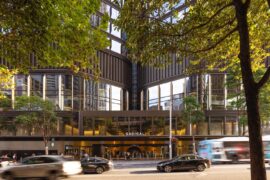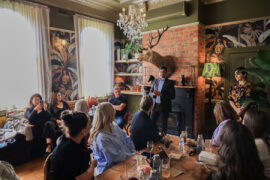Mary Jane McCraven reports from Schneider Electric on the future of connected buildings, and the value of the data they’ll provide.

November 27th, 2017
When looking to the future of buildings, one thing has become apparent to Schneider Electric: in the coming decades, buildings will become increasingly connected. As of 2014, overall connectivity penetration rates across all buildings systems were only at 16 per cent. This rate will rise steadily over the coming years, and mainstream penetration (meaning 50 per cent of all building systems and devices will be connected) will likely be achieved by 2025.
In fact, the IoT market for commercial buildings is expected to grow 25 per cent annually to become more than a US$85 billion industry in 2020. By 2020 it is expected that there will be 25 billion connected devices.
We’re in the midst of a revolution in the way that buildings are run. Occupants want more control over their spaces than ever before and live by the “there’s an app for that” mantra that dominates every aspect of their lives. At the same time, advances in mobile and cloud-based technologies as well as the IoT are creating enormous opportunities for information gathering and sharing and will have an astounding impact on the way buildings are run.
As buildings become more dynamic, the possibility to have a greater impact on energy consumption, utility bills and the quality of service to building occupants is very real. The integrated workplace of the future is no longer a pipe dream reserved only for the largest of companies. It can become a reality for organisations in a variety of industries and will prove to be a valuable competitive advantage.
Seventy per cent of decision-makers see the business value of IoT, and 63 percent of organisations plan to leverage IoT to better analyse behaviour and improve service levels.
The next challenge on the horizon is for facility managers and building owners to be able to understand, analyse and use the data from their newly connected buildings. Connected building management systems will serve as the backbone of buildings of the future by churning out useful data that leads to action and drives return on investment.
Here’s a glimpse of what’s in store in the years ahead:
Commercial buildings have come far, fast and are still rapidly evolving. Keeping up with building management requires a solution that can handle the complexity of joining multiple systems and one that is agile enough to scale as more things become more connected.
Learn more about the systems that will drive the efficient and connected buildings of tomorrow here. And check out this infographic that looks at the key technologies that make buildings of the past, present and future more efficient, comfortable, sustainable and reliable.
How will you use building technology to bring innovation to every level of your organisation?
INDESIGN is on instagram
Follow @indesignlive
A searchable and comprehensive guide for specifying leading products and their suppliers
Keep up to date with the latest and greatest from our industry BFF's!

From the spark of an idea on the page to the launch of new pieces in a showroom is a journey every aspiring industrial and furnishing designer imagines making.

Rising above the new Sydney Metro Gadigal Station on Pitt Street, Investa’s Parkline Place is redefining the office property aesthetic.

London-based design duo Raw Edges have joined forces with Established & Sons and Tongue & Groove to introduce Wall to Wall – a hand-stained, “living collection” that transforms parquet flooring into a canvas of colour, pattern, and possibility.

Schneider Electric’s new range are making bulky outlets a thing of the past with the new UNICA X collection.

In this comment piece by Lin (Leo) Meng, computational design lead at HDR, we hear about the interface of data and design.
The internet never sleeps! Here's the stuff you might have missed

Humanscale’s new showroom is about the modern workplace, with ergonomic excellence, sustainable design and architectural heritage in Singapore.

Guests joined Cosentino for a behind-the-scenes look at The Block homes, discovering new materials and creative partnerships.